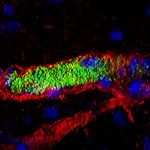Lien vers Pubmed [PMID] – 22484032
Microvasc. Res. 2012 Jul;84(1):94-8
The aims of our study were to investigate effects of postnatal overnutrition, obtained by restricting the number of pups per litter, on microcirculatory reactivity, fat depots, its total percentage and lipid profile. Microvascular reactivity was evaluated in the cremaster muscle of 24 hamsters divided into four groups, with 6 animals in each one: normal (NL) and restricted (RL) litter groups, both at 6th and 21st weeks of age. The NL group had 8-9 pups and the RL 3 pups per litter and to avoid the litter effect, only one animal was used per litter. The results have shown that the RL group had higher velocity of weight, body mass and fat gain compared to the NL one at weeks 6 and 21. Significant differences were also observed on urogenital fat depot, total cholesterol and low density lipoprotein between groups. At the lowest concentration of Ach, the RL group showed smaller arteriolar dilatation at the 21st than at the 6th week [5(3-13) vs 19(8-40)%, p<0.01] while the NL one did not show any difference within the group. The highest concentration of Ach at the 21th week pointed to endothelial-dependent microvascular dysfunction in RL compared to NL [3(8-26) vs. 13(8-26)%, p<0.05]. Endothelial-independent microvascular reactivity was similar between groups. Our data suggest that postnatal overnutrition is associated to muscle endothelial-dependent microvascular dysfunction, greater body mass and total percentage of fat and impaired the lipid profile. In conclusion, the imprinting promoted by this experimental model of obesity was able to influence microvascular reactivity later in life.

